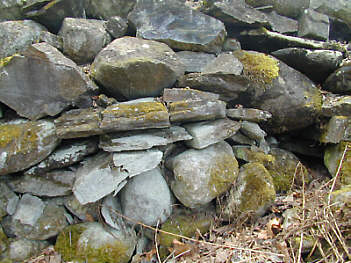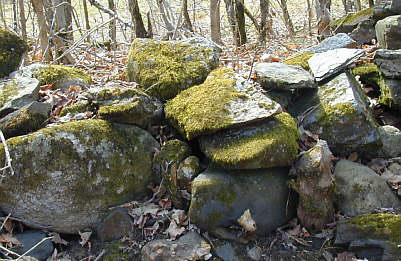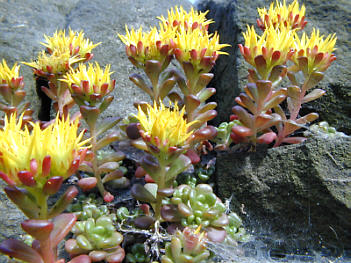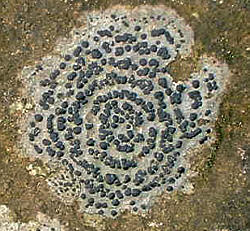|
Reflections on the fauna and flora
of rock wall highways
by W H Amos, Vermont, USA |

A Vermont rock wall highway. (Image - W. Amos) |
Our regional Interstate is well-traveled these days, but it's a far cry from the busy superhighway behind our house. This major thoroughfare has two-way traffic all day and all night long, plus motel stops and permanent homes scattered along the way, one after the next. I call it I-21 (honoring an age I scarcely remember).
It is a rock wall.

A Vermont rock wall. Rich in mosses, lichens and habitats
for birds, mammals and invertebrates. (Image - W. Amos)The work of our predecessors in northern states was prodigious. We don't have to read historical accounts or examine old photos to realize this. Evidence of their labors remain everywhere, long after houses collapse and fields turn into timberland. Our small efforts to build ornamental stone walls pale in comparison to the sturdy rock boundaries that course up and down hills, often passing straight through today's forests. Some are built of boulders that would challenge a modern front loader; others consist of thousands (tens of thousands) of stones, every one having been picked out of the soil and transported to where a wall was being built. There is an old stone-boat in our barn, an enormous, heavy sled on which rocks once were piled, then drawn by a team of oxen to a new location. I wish I could have seen it at work a 150 years ago, because the foundations of the same barn, and an early part of our house, are made up of Volkswagen-sized glacial boulders pried out of ancient soil.
I remember hearing about a man who walked from far away to a place near here in Colonial times. Upon arrival, he felled enough trees to create a clearing, built a lean-to in which he spent the winter, cutting down more trees all the while, then walked back south the next spring. He brought his wife, children, and such belongings as they had to his new homestead by ox cart, built a log house, and pried rocks by the thousands out of the enlarging fields. These rocks he used to define his property. No doubt the walls he built still lie where he placed them, which could well be on my property, or yours.
Parenthetically, I also remember a friend thirty years ago, an elderly farmer who came to mow my rough overgrown fields with ancient tractor and sicklebar (its teeth continually shattered by elevated stones and rocks that had worked their way to the surface). With typical flatlander's attempt to strike up a conversation, I asked him how many acres he owned. Why, crimy, he replied, I don't own any. No 'un can. I just do the best I can with the land I'm on until it passes to the next man.
How natural his response. How natural the concept for every living thing. Most animals stake out territory, which they stoutly defend during their occupancy, but just as naturally give it up without claim when their use—or their life—is done. Their transit to and from work is purposeful and cooperatively shared, and it's the highways upon which they travel that interest me.
We build massive roadways for cars and trucks, but old rock wall thoroughfares are more permanent and are certainly more heavily used. Consider a time when Western culture had not yet arrived. Native Americans walked softly over the land, their paths following natural contours. When unused for long, the trails were quickly overgrown. And when little traveled, our own paved roads crack as pioneering plants push through; soon black macadam is obliterated by greenery. Not so a rock wall.
Several centuries ago we appeared on the scene and levered rocks into great long walls that served two purposes: as stockpiles of unwanted stones removed from cultivated fields; and to let neighbors know, this is mine. Keep out.
How wild animals must have rejoiced over this development. At no time in the past had there been anything like a rock highway. A ground squirrel would have a good home in an outcropping of ledge, but between it and the next bare rock face might lie a hundred yards of forest populated by hungry owls and weasels. With a long stone wall, a chipmunk traverses a hillside with near impunity, ducking into narrowed openings whenever the first alarming shadow appears or furtive footprint is heard.
When visiting our bathroom—whose window looks upon the rock garden with its stone wall backdrop—without fail I glance at that rocky rampart. (In thirty years of summer and full-time residence, I calculate I've looked at the wall 65,000 times from that window alone.)
Traffic along the wall (or crossing over, or stopping to rest) is varied and frequent. Here is what I've seen, arranged in descending order of size (cats and dogs not included): deer, coyote, fox, raccoon, skunk, snowshoe hare, woodchuck, fisher, gray squirrel, wood rat, red squirrel, weasel (ermine), chipmunk, meadow vole, deermouse, garter snake, American toad, and wood frog. Birds include turkey, barred owl, sharpshin hawk, raven, ruffed grouse, crow, and a whole slew of flying and perching birds, great and small. Bluejays alight and scold, juncos scratch leaves away, nuthatches explore cavities.
I go out and sit on the wall, or kneel to peer into its recesses, or take a magnifier and examine its many surfaces. A down-sized parade goes on, for which an accounting is impossible. There are beetles of many sorts, locusts, crickets, true bugs, caterpillars and pupae, cavity dwelling bees and wasps, earwigs, ants, springtails, wolf spiders and others of the spider clan, centipedes, millipedes, harvestmen, mites, and countless other smaller, very busy creatures.
Since they are capable of movement, a rock wall's animal inhabitants select favored locations according need, not orientation or age of stone, so one rock surface or cavity may be as well-populated as another. It's up to you to determine why, thereby entering an insect's mind. (Yes, mind. Read Donald R. Griffin's Animal Minds.)

A stonecrop (Sedum); a plant commonly seen on
northern England dry stone walls (Image - D. Walker).Don't neglect plants living on the wall or within its crevices: coarse jungly or fine velvet mosses, horsetails, clubmosses, and ferns. Birch and maple seedlings make brave beginnings rooted in accumulated humus. The widest assortment is found among lichens, those strange partnerships between fungus and alga that take on the appearance (and the names) of individual species. There are flat encrusting lichens, others resembling curly scales, and the towering upright sort. They are everywhere on the rocks, slow to appear and to grow, seemingly nonspecific when it comes to where they live as long as there is a modicum of light.
Not so the preferential establishment of mosses, liverworts, and other green plants. All are clearly zoned in response to the sun, moisture, and to some degree a compass-bearing. Certain forms grow only on the north side of rocks, some prefer the south, some are uncaring and prosper where diffused light arrives from any direction.
When a fallen, decaying branch becomes wedged between the rocks, it nourishes fungi of every size and color, and perhaps a colony of those mysterious and fascinating slime molds that carry on partly as animal, partly plant.

A lichen on a northern England
dry stone wall. (Image - D. Walker)A new wall doesn't always tell the truth, especially if some of its component rocks have recently come from elsewhere, dumped there by a farmer clearing a new field. Or a single stone with north-preferring moss on one side might be shifted so the plant colony now faces south. Maybe it will survive for a while, maybe not.